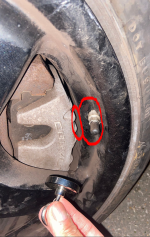For C5s, you need the magnet, the electronic TPMS tools are for newer designed TPMS that can work with C5s
More clearly, stock TPMS for C5s magnet must be used
If 3rd prty ones stated working with C5s but instead of a magnet to sync them to the remote controller uses a electronic TPMS tool
that awakes the sensor and also programs them
The tire pressure monitoring system
for 97-00 cars differs from the 01-04 C5s, and the latter further differs from the C6.
All of them use 315 MHz for US cars and 433 for European ones
Caution ! Do not read this while drunk, as it could make you puke ! 
Part 1 - Receiver Module
The RFA or remote function adapter module in the C5 is responsible for receiving telemetry packets from the four tires sensors, keeping track of the sensor’s learned unique identifiers, as well as performing similar tasks for the vehicle’s remote entry fobs.
When data is received from any of these inputs it then transmits data on the class 2 serial bus (aka ALDL) to other modules.
The early model C5 RFA modules were configured to accept a certain frequency and encoding of data, the domestic RFA modules for the 97-00 Corvettes were configured to decode transmissions on 315mhz using ASK or amplitude shift keying modulation.
This modulation would be synonymous with how AM broadcast radio modulates the analog audio signal. Starting with 01, the remaining model years of the C5 switched to FSK or frequency shift keying modulation, also on the 315mhz center frequency.
It should surprise no-one that FSK modulation is likewise synonymous with FM broadcast radio where changes in frequency around a center frequency is used to modulate / encode the analog (in our case digital) signal.
This all may sound extremely complicated, and at the technical level it is. But for those of us just wanting to make the ‘service tire monitor’ warning go away, it doesn’t need to be!
“
Domestic” Disclaimer:
If you took notice of the word “domestic” in the 2nd previous paragraph, here’s its relevance. In most production years, GM produced a substantial number of C5s that were destined for export to foreign markets. I’m not entirely clear on all the details, but one of importance to us is that at the time 315mhz was a regulated frequency in Europe, and possibly Japan, and those vehicles would have been equipped with RFA modules set to receive TPMS telemetry on the 433mhz frequency, as well as being equipped with similarly capable tire sensors.
This detail becomes important if you’re trying to replace sensors in a car that was built for export to these markets, as the North American 315mhz sensors simply won’t get you anywhere.
RFA Module Swaps
While we’re discussing the RFA module it would be wise to bring up the subject of module swaps as the older ASK modulation sensors and key fobs began to become more difficult (and expensive) to source, some owners opted to swap the RFA module from a 01-04 C5 into their early model C5.
One would have to research the part #s further to be certain, but this is something to consider if you’re working on a vehicle with an unknown past.
Part 2 – Programming, Training or Relearn
Let’s clear up the differences.
Training / Relearn
Overwhelmingly in the context of replacing sensors, we will be training or relearning.
The process by which this happens can be initiated from the DIC with the following (condensed) sequence:
1) with key on, engine off clear any DIC messages with the ‘reset’ button
2) press the ‘options’ button repeatedly until the DIC display goes blank
3) press and hold the ‘reset’ button until ‘FOB TRAINING’ diplays on the DIC
4) press the ‘options’ button again until ‘TIRE TRAINING’ displays on the DIC
5) press the ‘reset’ button – if vehicle is so equipped / configured ‘LEARN L FRONT TIRE’ will display along with the horn sounding
6) trigger the sensor in each tire with a suitable trigger device in a clockwise manner… (yada yada)
7) the horn honks twice signaling the process is complete
Sensor relearn can also be initiated by a scan tool via the class 2 serial bus (aka ALDL) with a device such as a Tech 2 or similar.
Both scenarios trigger the same condition. What’s important is what happens next.
Once the RFA module receives the proper sequence of instructions from the class 2 serial bus, it switches into relearn mode.
This can be for a new / replacement / additional key fob, or a new set of tire sensors or a new arrangement of sensors (for instance after having rotated tire locations).
When the relearn mode requested is for tire sensors, the RFA is instructed to listen for transmissions from tire sensors on it’s allocated frequency, modulation and encoding configuration.
When it decodes a valid unique transmission it hasn’t already heard during the current relearn session, it assigns that sensor’s unique identifier to a location in RAM (temporary memory) in the order of driver’s front, passenger’s front, passenger’s rear, and finally driver’s rear.
Each time a location is “learned” it sends a message to the BCM to honk the horn to alert the user that a valid sensor was learned, and to move to the next location. When all four locations have been relearned it stores the sensor identifiers semi-permanently in eeprom and instructs the BCM to honk the horn twice to signify a successful relearning sequence.
This may be the most important bit of information to take in here during the relearn sequence the technician (you) must somehow instruct the sensors attached to the valve stems to wake up and transmit their telemetry packet.










